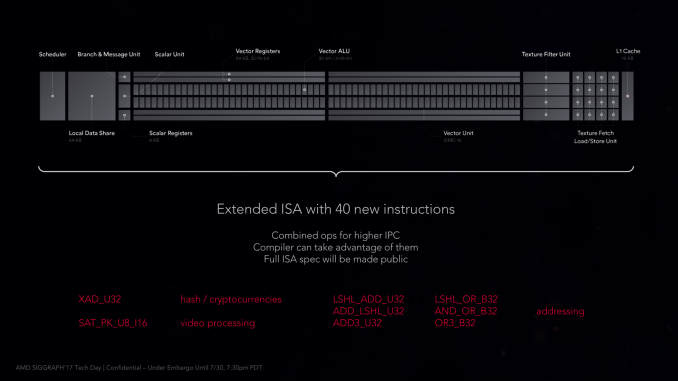The AMD Radeon RX Vega 64 & RX Vega 56 Review: Vega Burning Bright
by Ryan Smith & Nate Oh on August 14, 2017 9:00 AM ESTThe Vega Architecture: AMD’s Brightest Day
From an architectural standpoint, AMD’s engineers consider the Vega architecture to be their most sweeping architectural change in five years. And looking over everything that has been added to the architecture, it’s easy to see why. In terms of core graphics/compute features, Vega introduces more than any other iteration of GCN before it.
Speaking of GCN, before getting too deep here, it’s interesting to note that at least publicly, AMD is shying away from the Graphics Core Next name. GCN doesn’t appear anywhere in AMD’s whitepaper, while in programmers’ documents such as the shader ISA, the name is still present. But at least for the purposes of public discussion, rather than using the term GCN 5, AMD is consistently calling it the Vega architecture. Though make no mistake, this is still very much GCN, so AMD’s basic GPU execution model remains.
So what does Vega bring to the table? Back in January we got what has turned out to be a fairly extensive high-level overview of Vega’s main architectural improvements. In a nutshell, Vega is:
- Higher clocks
- Double rate FP16 math (Rapid Packed Math)
- HBM2
- New memory page management for the high-bandwidth cache controller
- Tiled rasterization (Draw Stream Binning Rasterizer)
- Increased ROP efficiency via L2 cache
- Improved geometry engine
- Primitive shading for even faster triangle culling
- Direct3D feature level 12_1 graphics features
- Improved display controllers
The interesting thing is that even with this significant number of changes, the Vega ISA is not a complete departure from the GCN4 ISA. AMD has added a number of new instructions – mostly for FP16 operations – along with some additional instructions that they expect to improve performance for video processing and some 8-bit integer operations, but nothing that radically upends Vega from earlier ISAs. So in terms of compute, Vega is still very comparable to Polaris and Fiji in terms of how data moves through the GPU.
Consequently, the burning question I think many will ask is if the effective compute IPC is significantly higher than Fiji, and the answer is no. AMD has actually taken significant pains to keep the throughput latency of a CU at 4 cycles (4 stages deep), however strictly speaking, existing code isn’t going to run any faster on Vega than earlier architectures. In order to wring the most out of Vega’s new CUs, you need to take advantage of the new compute features. Note that this doesn’t mean that compilers can’t take advantage of them on their own, but especially with the datatype matters, it’s important that code be designed for lower precision datatypes to begin with.











213 Comments
View All Comments
MatthiasP - Monday, August 14, 2017 - link
Only poor people buy the air cooled Vega and not the liquid one.FreckledTrout - Monday, August 14, 2017 - link
LOL I care about power consumption because it makes my computer loud. Did you see how loud t he Vega 64 is, way way to many db's for me. So some not "poor" people care.Aldaris - Monday, August 14, 2017 - link
Freckled, did you not pay attention to that graph? It's basically as loud as Nvidia's offerings.sorten - Monday, August 14, 2017 - link
If by "basically as loud" you mean that the AMD cards are 10% louder, then yes. Power draw translates to heat and, typically, noise. I would never buy the AMD cards given the power draw, but to each their own.Brett Howse - Monday, August 14, 2017 - link
dB is a logarithmic scale. 3dB means twice as much sound, although we don't perceive it as that much. Closer to 10 dB would be perceived as twice as loud. Vega 64 vs 1080 FE is about 7 dB difference, which isn't "basically as loud" it's going to be perceived as a lot louder.Lazacom - Tuesday, August 15, 2017 - link
Nope, logarithmic sound scale means 3dB is around 23% larger amplitude of sound waves. 10dB is perfect 2 times more. But our ears usually don't register 1-3dB difference. On the other hand, 7dB should be heard as difference, but again depends what frequencies are most loud, around 1kHz are most noticeable. If they wrote it basically as loud, probably there are lower frequencies spikes contrary to 1080Ti...bcronce - Tuesday, August 15, 2017 - link
Decibel is base 10. 10dB is 10x more energy. 3dB is about 47% more energy.Dug - Tuesday, August 15, 2017 - link
Anyone that deals with audio, knows that 3db is noticeable. 1db is perceivable, but not usually noticed if it's constant. The issue with sound from a case is that it can actually be like a speaker, so just because the card is 3db more at 1m in free air, it can become quite a bit louder due to cabinet size and materials. Just like putting a case under a desk can sometimes be louder than if on top of the desk. Last is heat. If case fans have to operate at higher levels to keep heat from video card down, then this will add to perceived loudness.Exodite - Monday, August 14, 2017 - link
While the power consumption of the cards, Vega 64 in particular, is disappointing I'd await 3rd party cooling systems before judging.The stock AMD cooling solution has been terrible since, well, forever really. And while I prefer AMD GPUs I've learned to avoid stock cards like the plague.
mapesdhs - Monday, August 14, 2017 - link
Exodite, 3rd party coolers can help with the noise, but I can't see them doing much about the power behaviour.